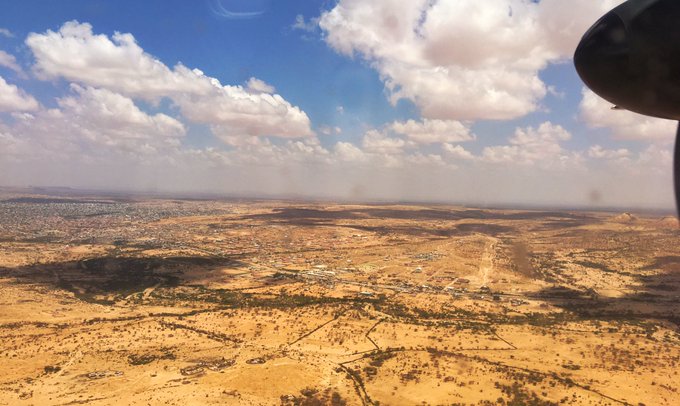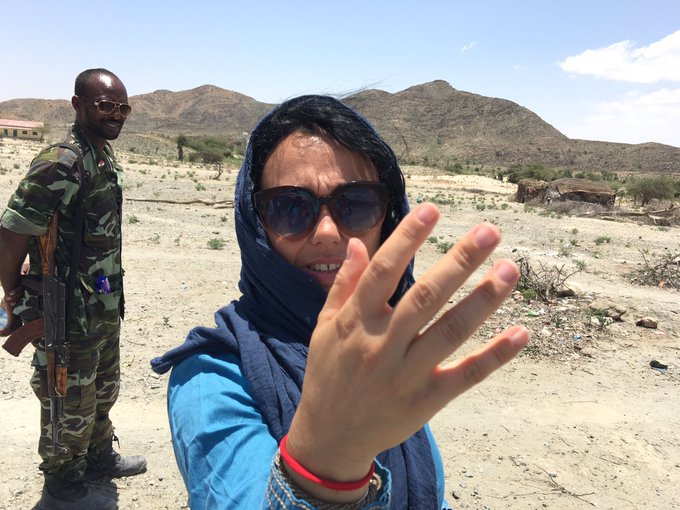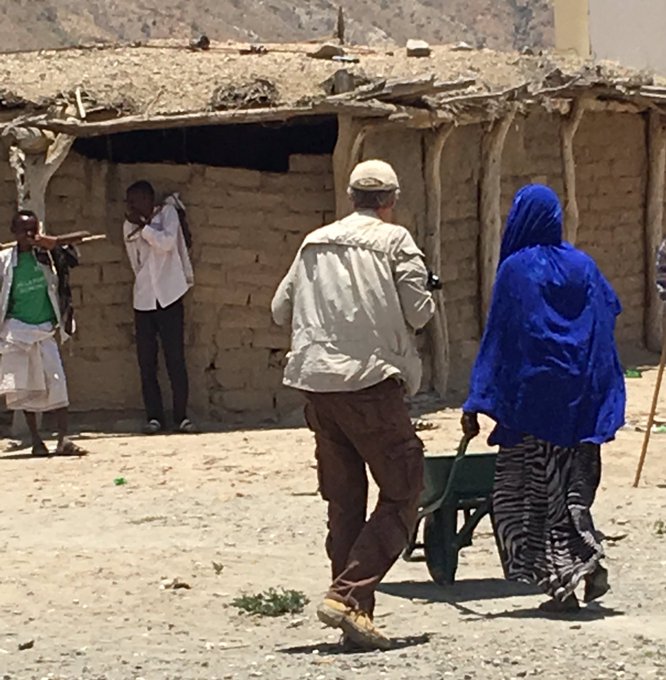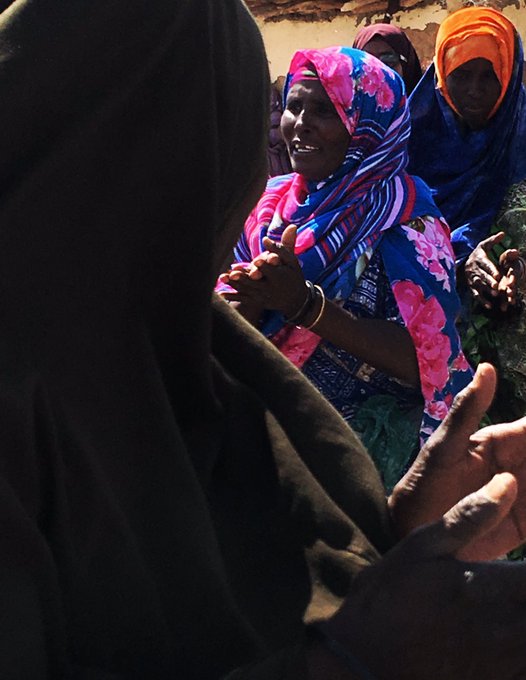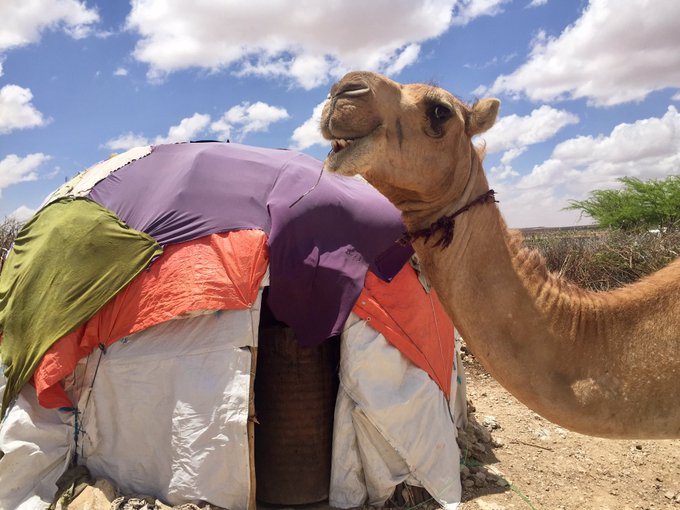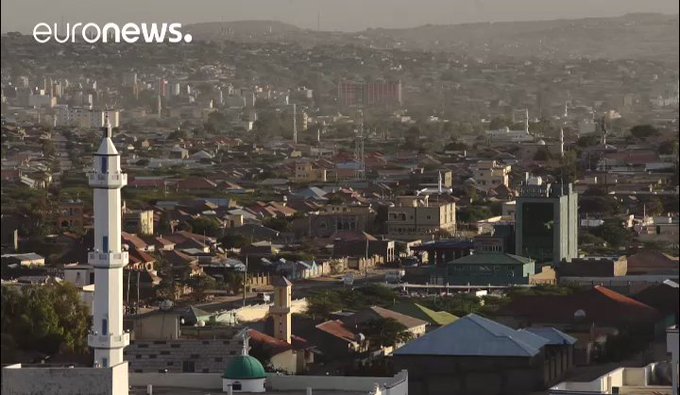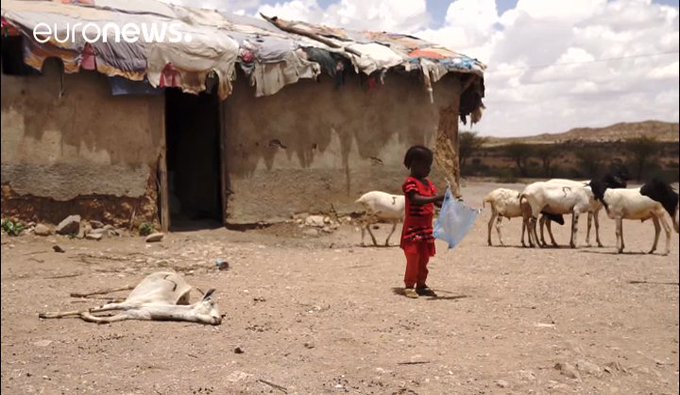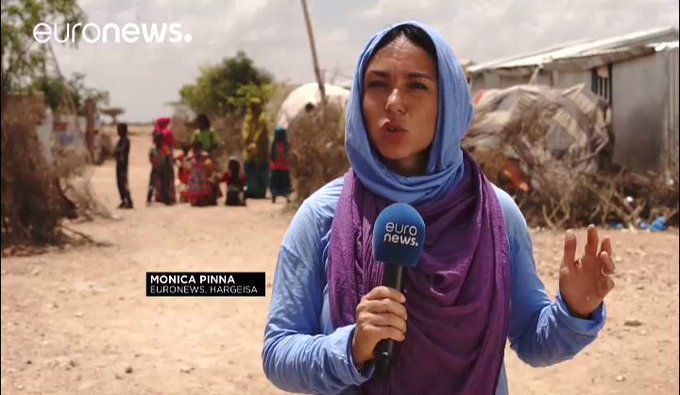Over 20 million people are threatened by drought in the Horn of Africa, Nigeria, Yemen and South Sudan.
In Somalia over six million need humanitarian assistance, around 680,000 people have fled the drought there since last November and around 1.4 million children are expected to suffer from acute malnutrition this year.
This is the fourth rainy season when there has been little or no rain in Somaliland, which was one of the first areas hit by drought three years ago.
This self-proclaimed state – which has a working political system, government institutions, a police force and its own currency – is recognised internationally as an autonomous region of Somalia.
Many livestock farmers in remote areas, such as the village of Sheikh Awaare which Euronews visited, have lost up to 80 percent of their animals.
Qoran Osman is one of those. She told our reporter Monica Pinna: “I was born here. I’ve never seen a drought like this. I had 200 goats and now I have 20 left.”
Qoran is among the residents selected by the NGO Concern Worldwide to receive a cash transfer she can use in the local shop.
The project, financed by the European Humanitarian Aid office, is helping 172 families of the 400 or so scattered around these mountains.
Qoran Osman explained: “I was given $112 (103 euros), it helps us to get by. I bought flour, oil, sugar and tea.”
The beneficiaries get a mobile phone sim card on to which the NGO has transferred money. The transaction takes place just outside the shop, the only place where – mostly – there a mobile network connection.
It is the first time the villagers in Sheikh Awaare have received any help since the drought began. To make sure it runs smoothly, now and in the future, the distribution system is closely monitored.
Mercy Gitau, who works for Concern Worldwide in Somalia, said: “The main issue is that they feel that very few are selected among those who are affected. We have planned three transfers for them, so it’s going to last up to the month of June. But we obviously know that the situation won’t have changed much because the rains are not looking good, so we know that they will still need support.”
The project is part of a wider strategy to try to head off famine before it happens. Somalia launched a pre-famine alert last January, and international aid efforts are already underway.
Euronews reporter Monica Pinna spoke to Heather Blackwell of EU Humanitarian Aid and asked her: “Just six years ago Somalia suffered a famine that cost the lives of over a quarter of a million people. How has the humanitarian response changed?”
Heather Blackwell replied: “Now the humanitarian response is gearing up and scaling up now, before a famine declaration is made, this time we have the information on food security deterioration, malnutrition numbers, the prices of food in the markets, are all indicators to us that something is happening. So this time we have used that information to respond earlier.”
Further south from Sheikh Awaare in the village of Baldheere the construction of a water tank has made a big difference to the local people. Euronews’ Monica Pinna explained: “In times of heavy drought like this, people depend on water distribution and on the ability to store it. Here in the village of Baldheere the rain that’s coming won’t be wasted.”
The water tank in Baldheere was completed last March. Concern has built around 50 tanks in Somalia in the past 25 years and around 20 in Somaliland more recently, mainly financed by the EU. Each family is allowed 40 litres per day.
That is the minimum quantity of water needed according to the World Health Organisation – about 20 litres per capita per day addresses basic hygiene needs and basic food hygiene.
Mercy Gitau of Concern Worldwide in Somalia told us about the Baldheere storage facility: “This tank contains 270,000 litres of water. That is enough water for 300 families for 20 days, at an average of 7.5 litres per person per day”.
Before the tank was built, getting water required huge effort.
Faduno Muse Habane, who lives in Baldheere, detailed what they had to do: “Sometimes we went to Aubare, which is six kilometres away, in Ethiopia. When there were tensions between the two countries the border was closed and we had to go 15 kilometres. I went early in the morning and sometimes I didn’t get back until 7.00 PM.”
Speaking at an international conference on Somalia in London on May 11 United Nations Secretary-General Antonio Guterres
Over 20 million people are threatened by drought in the Horn of Africa, Nigeria, Yemen and South Sudan.
In Somalia over six million need humanitarian assistance, around 680,000 people have fled the drought there since last November and around 1.4 million children are expected to suffer from acute malnutrition this year.
This is the fourth rainy season when there has been little or no rain in Somaliland, which was one of the first areas hit by drought three years ago.
This self-proclaimed state – which has a working political system, government institutions, a police force and its own currency – is recognised internationally as an autonomous region of Somalia.
Many livestock farmers in remote areas, such as the village of Sheikh Awaare which Euronews visited, have lost up to 80 percent of their animals.
Qoran Osman is one of those. She told our reporter Monica Pinna: “I was born here. I’ve never seen a drought like this. I had 200 goats and now I have 20 left.”
Qoran is among the residents selected by the NGO Concern Worldwide to receive a cash transfer she can use in the local shop.
The project, financed by the European Humanitarian Aid office, is helping 172 families of the 400 or so scattered around these mountains.
Qoran Osman explained: “I was given $112 (103 euros), it helps us to get by. I bought flour, oil, sugar and tea.”
The beneficiaries get a mobile phone sim card on to which the NGO has transferred money. The transaction takes place just outside the shop, the only place where – mostly – there a mobile network connection.
#AidZone went to remote areas of #somaliland to see what's being done to help prevent famine after 3 years of drought @eu_echo @Concern pic.twitter.com/BIPyY1A3UQ
— Monica Pinna (@_MonicaPinna) April 26, 2017
The NGO Concern supports 92,000 families in Somalia, with everything from water supplies to nutrition and health interventions. Nearly 23,000 received support in the form of cash and EU Humanitarian Aid has given money to help nearly 14,000 people. Cash assistance in Somaliland has reached 2,200 people.
It is the first time the villagers in Sheikh Awaare have received any help since the drought began. To make sure it runs smoothly, now and in the future, the distribution system is closely monitored.
Mercy Gitau, who works for Concern Worldwide in Somalia, said: “The main issue is that they feel that very few are selected among those who are affected. We have planned three transfers for them, so it’s going to last up to the month of June. But we obviously know that the situation won’t have changed much because the rains are not looking good, so we know that they will still need support.”
The project is part of a wider strategy to try to head off famine before it happens. Somalia launched a pre-famine alert last January, and international aid efforts are already underway.
Euronews reporter Monica Pinna spoke to Heather Blackwell of EU Humanitarian Aid and asked her: “Just six years ago Somalia suffered a famine that cost the lives of over a quarter of a million people. How has the humanitarian response changed?”
Heather Blackwell replied: “Now the humanitarian response is gearing up and scaling up now, before a famine declaration is made, this time we have the information on food security deterioration, malnutrition numbers, the prices of food in the markets, are all indicators to us that something is happening. So this time we have used that information to respond earlier.”
In Somaliland filming with
_MonicaPinna</a> for <a href="https://twitter.com/euronews">euronews ‘s 2nd #AidZone series: millions threatened by #drought pic.twitter.com/or9Y2YiKQK— Anouk Delafortrie (@ECHO_CESAfrica) 26 aprile 2017
An extreme lack of access to water worsens the crisis in arid areas. Some communities rely on water that is brought in by tanker that they buy when they can scrape together enough money, though the drought means prices have risen.
Further south from Sheikh Awaare in the village of Baldheere the construction of a water tank has made a big difference to the local people. Euronews’ Monica Pinna explained: “In times of heavy drought like this, people depend on water distribution and on the ability to store it. Here in the village of Baldheere the rain that’s coming won’t be wasted.”
The water tank in Baldheere was completed last March. Concern has built around 50 tanks in Somalia in the past 25 years and around 20 in Somaliland more recently, mainly financed by the EU. Each family is allowed 40 litres per day.
That is the minimum quantity of water needed according to the World Health Organisation – about 20 litres per capita per day addresses basic hygiene needs and basic food hygiene.
Mercy Gitau of Concern Worldwide in Somalia told us about the Baldheere storage facility: “This tank contains 270,000 litres of water. That is enough water for 300 families for 20 days, at an average of 7.5 litres per person per day”.
Before the tank was built, getting water required huge effort.
Faduno Muse Habane, who lives in Baldheere, detailed what they had to do: “Sometimes we went to Aubare, which is six kilometres away, in Ethiopia. When there were tensions between the two countries the border was closed and we had to go 15 kilometres. I went early in the morning and sometimes I didn’t get back until 7.00 PM.”
#Alhamdulilaah tough #Raining begin #Somaliland, still NGO’s warn Famine, if not responded needed relief Cheer
euronews</a> <a href="https://twitter.com/_MonicaPinna">_MonicaPinnapic.twitter.com/4iYjiGonn6— Mohamoud Walaaleye (@Ladhka) 1 maggio 2017
The NGOs say they will need more money to help 5.5 million people by the end of the year in the whole of Somalia.
Speaking at an international conference on Somalia in London on May 11 United Nations Secretary-General Antonio Guterres
Over 20 million people are threatened by drought in the Horn of Africa, Nigeria, Yemen and South Sudan.
In Somalia over six million need humanitarian assistance, around 680,000 people have fled the drought there since last November and around 1.4 million children are expected to suffer from acute malnutrition this year. This is the fourth rainy season when there has been little or no rain in Somaliland, which was one of the first areas hit by drought three years ago.
This is the fourth rainy season when there has been little or no rain in Somaliland, which was one of the first areas hit by drought three years ago.
This self-proclaimed state – which has a working political system, government institutions, a police force and its own currency – is recognised internationally as an autonomous region of Somalia.
Many livestock farmers in remote areas, such as the village of Sheikh Awaare which Euronews visited, have lost up to 80 percent of their animals.
Qoran Osman is one of those. She told our reporter Monica Pinna: “I was born here. I’ve never seen a drought like this. I had 200 goats and now I have 20 left.”
Qoran is among the residents selected by the NGO Concern Worldwide to receive a cash transfer she can use in the local shop.
The project, financed by the European Humanitarian Aid office, is helping 172 families of the 400 or so scattered around these mountains.
Qoran Osman explained: “I was given $112 (103 euros), it helps us to get by. I bought flour, oil, sugar and tea.”
The beneficiaries get a mobile phone sim card on to which the NGO has transferred money. The transaction takes place just outside the shop, the only place where – mostly – there a mobile network connection.
#AidZone went to remote areas of #somaliland to see what’s being done to help prevent famine after 3 years of drought
eu_echo</a> <a href="https://twitter.com/Concern">Concernpic.twitter.com/BIPyY1A3UQ— Monica Pinna (@_MonicaPinna) 26 aprile 2017
The NGO Concern supports 92,000 families in Somalia, with everything from water supplies to nutrition and health interventions. Nearly 23,000 received support in the form of cash and EU Humanitarian Aid has given money to help nearly 14,000 people. Cash assistance in Somaliland has reached 2,200 people.
It is the first time the villagers in Sheikh Awaare have received any help since the drought began. To make sure it runs smoothly, now and in the future, the distribution system is closely monitored.
Mercy Gitau, who works for Concern Worldwide in Somalia, said: “The main issue is that they feel that very few are selected among those who are affected. We have planned three transfers for them, so it’s going to last up to the month of June. But we obviously know that the situation won’t have changed much because the rains are not looking good, so we know that they will still need support.”
The project is part of a wider strategy to try to head off famine before it happens. Somalia launched a pre-famine alert last January, and international aid efforts are already underway.
Euronews reporter Monica Pinna spoke to Heather Blackwell of EU Humanitarian Aid and asked her: “Just six years ago Somalia suffered a famine that cost the lives of over a quarter of a million people. How has the humanitarian response changed?”
Heather Blackwell replied: “Now the humanitarian response is gearing up and scaling up now, before a famine declaration is made, this time we have the information on food security deterioration, malnutrition numbers, the prices of food in the markets, are all indicators to us that something is happening. So this time we have used that information to respond earlier.”
In Somaliland filming with
_MonicaPinna</a> for <a href="https://twitter.com/euronews">euronews ‘s 2nd #AidZone series: millions threatened by #drought pic.twitter.com/or9Y2YiKQK— Anouk Delafortrie (@ECHO_CESAfrica) 26 aprile 2017
An extreme lack of access to water worsens the crisis in arid areas. Some communities rely on water that is brought in by tanker that they buy when they can scrape together enough money, though the drought means prices have risen.
Further south from Sheikh Awaare in the village of Baldheere the construction of a water tank has made a big difference to the local people. Euronews’ Monica Pinna explained: “In times of heavy drought like this, people depend on water distribution and on the ability to store it. Here in the village of Baldheere the rain that’s coming won’t be wasted.”
The water tank in Baldheere was completed last March. Concern has built around 50 tanks in Somalia in the past 25 years and around 20 in Somaliland more recently, mainly financed by the EU. Each family is allowed 40 litres per day.
That is the minimum quantity of water needed according to the World Health Organisation – about 20 litres per capita per day addresses basic hygiene needs and basic food hygiene.
Mercy Gitau of Concern Worldwide in Somalia told us about the Baldheere storage facility: “This tank contains 270,000 litres of water. That is enough water for 300 families for 20 days, at an average of 7.5 litres per person per day”.
Before the tank was built, getting water required huge effort.
Faduno Muse Habane, who lives in Baldheere, detailed what they had to do: “Sometimes we went to Aubare, which is six kilometres away, in Ethiopia. When there were tensions between the two countries the border was closed and we had to go 15 kilometres. I went early in the morning and sometimes I didn’t get back until 7.00 PM.”
#Alhamdulilaah tough #Raining begin #Somaliland, still NGO’s warn Famine, if not responded needed relief Cheer
euronews</a> <a href="https://twitter.com/_MonicaPinna">_MonicaPinnapic.twitter.com/4iYjiGonn6— Mohamoud Walaaleye (@Ladhka) 1 maggio 2017
The NGOs say they will need more money to help 5.5 million people by the end of the year in the whole of Somalia.
Speaking at an international conference on Somalia in London on May 11 United Nations Secretary-General Antonio Guterres said it is seeking a further $900 million (827 million euros) this year for the crisis there.
The local people hope that this rainy season will bring rain and a return to normal life.
London Somalia Conference 2017: Security, humanitarian aid tops agenda – africanews https://t.co/jcEslxsJo3
— Humanitarian Affairs (@HumanitaAffairs) May 11, 2017























